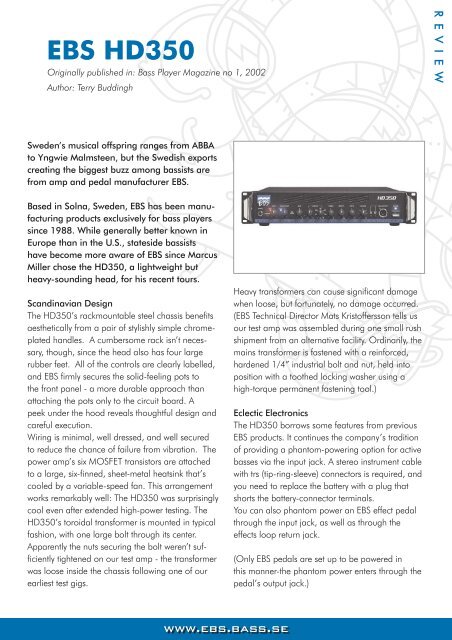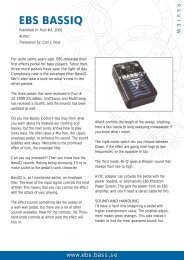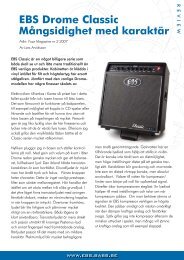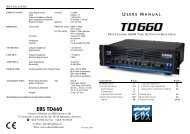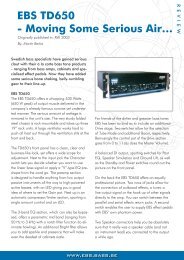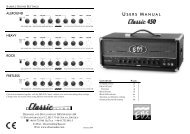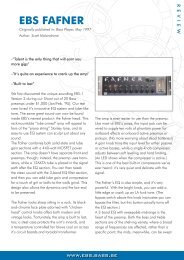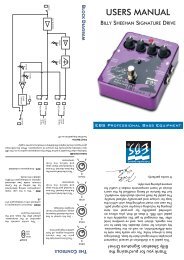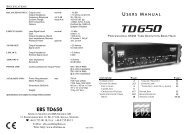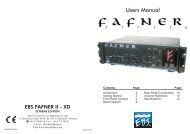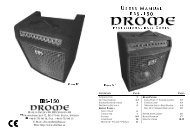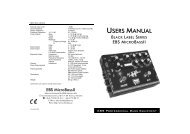Bass Player #1 2002 - EBS
Bass Player #1 2002 - EBS
Bass Player #1 2002 - EBS
Create successful ePaper yourself
Turn your PDF publications into a flip-book with our unique Google optimized e-Paper software.
<strong>EBS</strong> HD350<br />
Originally published in: <strong>Bass</strong> <strong>Player</strong> Magazine no 1, <strong>2002</strong><br />
Author: Terry Buddingh<br />
REVIEW<br />
Sweden’s musical offspring ranges from ABBA<br />
to Yngwie Malmsteen, but the Swedish exports<br />
creating the biggest buzz among bassists are<br />
from amp and pedal manufacturer <strong>EBS</strong>.<br />
Based in Solna, Sweden, <strong>EBS</strong> has been manufacturing<br />
products exclusively for bass players<br />
since 1988. While generally better known in<br />
Europe than in the U.S., stateside bassists<br />
have become more aware of <strong>EBS</strong> since Marcus<br />
Miller chose the HD350, a lightweight but<br />
heavy-sounding head, for his recent tours.<br />
Scandinavian Design<br />
The HD350’s rackmountable steel chassis benefits<br />
aesthetically from a pair of stylishly simple chromeplated<br />
handles. A cumbersome rack isn’t necessary,<br />
though, since the head also has four large<br />
rubber feet. All of the controls are clearly labelled,<br />
and <strong>EBS</strong> firmly secures the solid-feeling pots to<br />
the front panel - a more durable approach than<br />
attaching the pots only to the circuit board. A<br />
peek under the hood reveals thoughtful design and<br />
careful execution.<br />
Wiring is minimal, well dressed, and well secured<br />
to reduce the chance of failure from vibration. The<br />
power amp’s six MOSFET transistors are attached<br />
to a large, six-finned, sheet-metal heatsink that’s<br />
cooled by a variable-speed fan. This arrangement<br />
works remarkably well: The HD350 was surprisingly<br />
cool even after extended high-power testing. The<br />
HD350’s toroidal transformer is mounted in typical<br />
fashion, with one large bolt through its center.<br />
Apparently the nuts securing the bolt weren’t sufficiently<br />
tightened on our test amp - the transformer<br />
was loose inside the chassis following one of our<br />
earliest test gigs.<br />
Heavy transformers can cause significant damage<br />
when loose, but fortunately, no damage occurred.<br />
(<strong>EBS</strong> Technical Director Mats Kristoffersson tells us<br />
our test amp was assembled during one small rush<br />
shipment from an alternative facility. Ordinarily, the<br />
mains transformer is fastened with a reinforced,<br />
hardened 1/4” industrial bolt and nut, held into<br />
position with a toothed locking washer using a<br />
high-torque permanent fastening tool.)<br />
Eclectic Electronics<br />
The HD350 borrows some features from previous<br />
<strong>EBS</strong> products. It continues the company’s tradition<br />
of providing a phantom-powering option for active<br />
basses via the input jack. A stereo instrument cable<br />
with trs (tip-ring-sleeve) connectors is required, and<br />
you need to replace the battery with a plug that<br />
shorts the battery-connector terminals.<br />
You can also phantom power an <strong>EBS</strong> effect pedal<br />
through the input jack, as well as through the<br />
effects loop return jack.<br />
(Only <strong>EBS</strong> pedals are set up to be powered in<br />
this manner-the phantom power enters through the<br />
pedal’s output jack.)<br />
www.ebs.bass.se
Also, only the last pedal in an effect chain can<br />
be phantom powered - the power can’t be passed<br />
through to other pedals. The compressor/limiter<br />
circuit comes with a prestigious pedigree:<br />
It’s a simplified version of <strong>EBS</strong>’s popular Multi-<br />
Comp pedal, being equivalent to a MultiComp in<br />
full-range standard compression mode. The single<br />
knob adjusts the compression ratio; the gain automatically<br />
adjusts to maintain a constant volume<br />
level. <strong>EBS</strong> borrowed the HD350’s drive circuit from<br />
its MultiDrive pedal. It simulates mild tube-like distortion,<br />
affecting only frequencies above 350Hz,<br />
to maintain clear and tight fundamentals. Because<br />
its output doesn’t compensate for gain changes, the<br />
drive circuit can boost the signal level considerably.<br />
The balanced output also has an authentic-sounding,<br />
switchable speaker simulator. This adds depth<br />
and midrange thickness, with rolled-off treble that<br />
reduces the dry, brittle ”gritch” you often encounter<br />
when using a direct box. Investigating The Funk The<br />
HD350’s versatile tone controls accommodate a<br />
variety of playing styles, but there’s no denying its<br />
true calling:<br />
This amp was born to funk.<br />
Engaging the character button applies the standard<br />
slap-approved mid scoop, accompanied by bass<br />
and treble boost to enhance the scoop and maintain<br />
a consistent volume level. Without any EQ<br />
tweaks, the head made a Fender J-<strong>Bass</strong> sound<br />
balanced, woody, and complex. Paired with a<br />
Hartke 4200 4x10, the HD350 reproduced busy<br />
thumbstyle playing effortlessly and with authority.<br />
There was no blurring or congestion in the lower<br />
midrange and below, a common problem with<br />
amps less suited for high-velocity slapping. The<br />
bright knob can apply just the right amount of highfrequency<br />
color to further illuminate high-string<br />
snaps. Combining a Fender P-<strong>Bass</strong> and an Eden<br />
D-410XLT cab worked well for mildly<br />
overdriven rock tones, which were helped by the<br />
drive knob’s added wool and midrange girth.<br />
The tone gets woollier and thicker as you increase<br />
the drive knob; it also begins to mimic tube-like<br />
compression at higher settings. Additional compression<br />
from the comp/limit knob can produce<br />
singing, guitar-like sustain with upper harmonics<br />
that gradually emerge from the distortion. I used<br />
the HD350 on a variety of gigs ranging from quiet<br />
jazz to loud R&B.<br />
It never took more than a few quick knob twists to<br />
adapt its sound to different musical and acoustical<br />
requirements. I found the semi-parametric mid’s<br />
unusually broad range (it actually extends from<br />
the bass to lower-treble) extremely valuable when<br />
dealing with less-than-ideal acoustics. Another staffer,<br />
who took the HD350 on a funk/R&B gig, dug<br />
the amp’s detailed fingerstyle tone as well as the<br />
crunchy highs and wide bottom of its muscular slap<br />
sound.<br />
Complaint Department<br />
It’s hard to check the position of the HD350’s buttons<br />
- they’re small and black and surrounded by a<br />
non-contrasting black panel. When you’re moving<br />
the amp, buttons can get bumped accidentally.<br />
Status-indicating LEDs could ensure that the buttons<br />
are in their desired positions. Tuner mute buttons<br />
have become standard on amps in the last few<br />
years; even though the HD350 has a tuner-out<br />
jack, a mute button is conspicuously absent. The<br />
HD350 has Speakon output jacks but no 1/4”<br />
output jacks. <strong>EBS</strong> tells us that European electricalsafety<br />
standards do not allow 1/4” jacks for highpower<br />
amplifier outputs - so don’t forget to pack<br />
those Speakon-equipped speaker cables on your<br />
way to the gig. Portable Smorgasbord The <strong>EBS</strong><br />
www.ebs.bass.se
HD350 proves that you don’t need an entire forest<br />
of knobs to get a good sound - just a few wellchosen<br />
(and well-voiced) tone controls. Its lightweight,<br />
compact size makes it painless to transport,<br />
and its reasonable price makes it painless on your<br />
pocket book as well. No, it won’t make you sound<br />
exactly like Marcus - he keeps the secret of his<br />
elusive sound under his hat.<br />
Tech Specs<br />
The HD350’s power amp uses two pairs of powersupply<br />
rails-the omplementary positive and negative<br />
voltages required by a typical solid-state amplifier’s<br />
output transistors. Under moderate power<br />
demands, the output transistors run on the lower<br />
voltage rails, producing less heat. (The hotter an<br />
amp runs, the more<br />
likely it is to fail.) It takes more power to faithfully<br />
reproduce snappy transients, so on demand, the<br />
amp temporarily ”switches gears” to the highervoltage<br />
supply rails for these more demanding signals.<br />
The result is a head that runs cool yet has a<br />
wide dynamic range. This type of design is typically<br />
called a Class G amplifier; <strong>EBS</strong> describes it as an<br />
”accelerated power amp.”<br />
Facts<br />
Power rating: 350 watts rms into 4ohms<br />
(4ohms minimum load)<br />
Dimensions: 19” x 12 1/2” x 3 1/2”<br />
Weight: 20 lbs<br />
Input impedance: 1Mohms<br />
Comp/Limit: Fixed threshold;<br />
maximum compression ratio 3:1<br />
Character pre-shape button:<br />
+6dB @ 75Hz, -2.5dB @ 800Hz, +3dB @ 6kHz<br />
Tone controls:<br />
bass: ±15dB @ 100Hz, shelving<br />
middle (semi-parametric): ±12dB @ 50Hz-3kHz<br />
treble: ±15dB @ 4kHz<br />
bright: +20dB (boost only) @ 10kHz<br />
Made in: Sweden<br />
List price: $1,195<br />
Warranty: One year limited<br />
<strong>EBS</strong> Sweden, www.ebs.bass.se<br />
Construction: 4<br />
Electronics: 4<br />
Ease of Use: 4,5<br />
Sound: 4,5<br />
Value: 4,5<br />
+<br />
Easy-to use, versatile, affordable, and lightweight.<br />
–<br />
Character and filter bypass settings can be hard to<br />
see. No tuner mute button.<br />
www.ebs.bass.se


